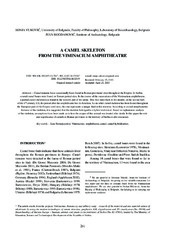Приказ основних података о документу
A Camel Skeleton from the Viminacium Amphitheatre
| dc.creator | Vuković, Sonja | |
| dc.creator | Bogdanović, Ivan | |
| dc.date.accessioned | 2024-01-03T17:21:58Z | |
| dc.date.available | 2024-01-03T17:21:58Z | |
| dc.date.issued | 2013 | |
| dc.identifier.issn | 0350-0241 | |
| dc.identifier.issn | 2406-0739 | |
| dc.identifier.uri | http://rai.ai.ac.rs/handle/123456789/1328 | |
| dc.description.abstract | Camel remains have occasionally been found in Roman provincial sites throughout the Empire. In Serbia, several camel bones were found on Roman period sites. In the course of the excavations of the Viminacium amphitheatre, a partial camel skeleton was found in the western part of the arena. This find dates back to the middle, or the second half, of the 4th century AD, the period after the amphitheatre lost its function. As no other camel skeleton has been found throughout the European part of the Empire until now, this one represents a unique find in this territory. According to mixed morphometric features of the skeleton, it is suggested that the skeleton belonged to a hybrid individual. Based on taphonomic analysis of the skeleton, assumptions have been made as to how the corpse of this animal was treated after death. In this paper the role and significance of camels in Roman provinces in the territory of Serbia is also discussed. | sr |
| dc.language.iso | en | sr |
| dc.publisher | Beograd : Arheološki institut Beograd | sr |
| dc.rights | openAccess | sr |
| dc.rights.uri | https://creativecommons.org/licenses/by-nc-nd/4.0/ | |
| dc.source | Starinar | sr |
| dc.subject | Late Roman period | sr |
| dc.subject | Viminacium | sr |
| dc.subject | amphitheatre | sr |
| dc.subject | came | sr |
| dc.subject | camel hybridisation | sr |
| dc.title | A Camel Skeleton from the Viminacium Amphitheatre | sr |
| dc.type | article | sr |
| dc.rights.license | BY-NC-ND | sr |
| dc.citation.epage | 267 | |
| dc.citation.issue | 63 | |
| dc.citation.spage | 251 | |
| dc.identifier.doi | 10.2298/sta1363251v | |
| dc.identifier.fulltext | http://rai.ai.ac.rs/bitstream/id/2446/bitstream_2446.pdf | |
| dc.type.version | publishedVersion | sr |


